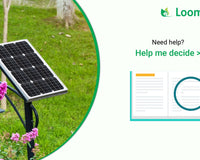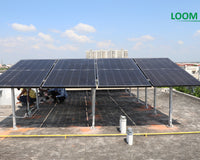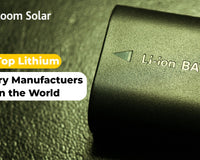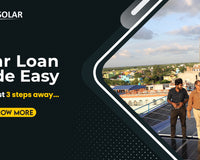The most common, low-cost, economic, and better operation On-Grid solar are used nowadays. Basic condition of On grid Solar generation, Batteries not available, hence can store energy and grid power required continually during generation & load sharing.
Quick Links
Benefits
On Grid solar system mostly used in Corporate Offices, Educational Institutions (University / Colleges / School) Hospital, Showroom, Factory, Government Buildings for reducing electricity bill.
1. Site Survey

Site survey is the main key of any plant, to identify & clear the vision for following things.
a. Based on the available location arrangement will decide-
Example-1- Installation on Roof Top required foundation pillars along with J bolt for PV structure fixing. Also we can use heavy duty anchor fastener Bolts to fix the PV module structure on the roof by anchoring on roof top.
Example-2- Installation on shades at building top are commonly used in manufacturing plants, warehouse and hospital. Required angle foundation arrangement to fix PV module structure on existing shades structure by welding or with Nut & Bolt connection. After fixing the PV module structure all the PV modules can be mound ion the structure with help of Nut & Bolts.
Example-3- Installation on parking areas, also similar kind of shade installation arrangement. But share direction need to check is the same on sun facing side or opposite direction on sun facing. In case of opposite sun facing, we can use angle arrangement to achieve maximum generation and efficiency of plant.
b. Generation capacity can be calculate

Capacity of plan can we calculate by available free shadow space area. Shadow analysis only required in case of any other building, water tank or tower shadow fall in to proposed solar area to analysis of the impact on solar generation per year.
c. Inverter and ACDB placement- Location of Inverter & ACDB also impact of generation and cost. Following thing should keep on mind before inverter placement are,

Inverter should be place near to PV module to avoid looses on DC cable and the minimum length of DC cable can be produce maximum solar output.
Inverter & ACDB shall be placed in covered area with proper cooling arrangement to increase the life of Inverter, However as per inverter manufacturer manuals / technical data sheet Inverter are suitable to use with ambient temperature of -10© to +65 degree Celsius & IP 66 protected.
All ACDB shall be placed in covered area, however outdoor type canopy based, IP65 DB’s can also be used for Metering & distribution.
d. Routing of cable and final termination location - This is also a part of site survey to decide the route of main ACDB outgoing AC cable in to existing customer LV Distribution and approximate length for coasting & procurement.
e. Monitoring Requirement –DC generation & output AC metering at multiple levels are required. DC generation measurement is part of Inverter hence not required any additional meter to monitor DC voltage and current. In ACDB Panel metering is required to monitor the AC outgoing supply and RS-485 communication mode will used with zero export device control the generation and required output.
f. Zero Export Device placement – Its brain of solar plant & Zero export required in case of not availability of Net Metering. Device will control the generation of inverters based on required load.
g. Location of Earthing Pit – To identified the space availability for earth pit and location of lighting arrestor (LA) connection as per requirement.

Also to verify the requirement of No. of earth pit as per site condition its part of site survey.
2. Capacity

Plant capacity can be calculated based on the required load in plant and available shadow free space for PV module fixing. However minimum (50 X 60) meter area required for approx. 100KW solar plate & for load calculation you can use Loom solar load calculator available in loom solar site, refer below link.
Loom solar Load calculator link required
3. Site Drawing / Design

After site survey and finalization of load requirement, following drawing are required to understand plant arrangement and working process
- Layout drawing of PV Module
- Single line diagram of interconnection
- LA fixing drawing with indication of LA location and earthing pit
- Water clearing arrangement drawing & location of water taps.
- PV Module structure drawing, GA & pillar based design (approx. 300X300mm)
- Shadow analysis report in case of shadow fall of any other high rise building or any other object.
- Bill of Material
- GTP of selected PV module (available with 320watt, 400 watt & 545 Watt) based on design
- GTP of required cable (DC Cable, AC cable)
- Inverter manual
a. No. of panels - No. of PV module requirement shall be depend upon the capacity of plant and selected type of PV Modules. For example 100KW plant, selected PV module with capacity of 400 Wp than the required plates are ((100X1000)/400) = 250. No. of PV module is completely depend on the selected capacity of PV module.
b. Generation – Yearly generation capacity also can be calculate with approximate of 330 days plant consideration. The report will be tentative based on some assumptions.
c. Shadow – Shadow analysis report required to check the PV modules are completely shadow free & no impact on generation. Hence in shadow analysis will check morning and evening sun location per month wise for complete of year. So many software’s are available in market for shadow analysis, however software sketchup pro version 2019/2020/2021 we can use.
4. Connection – There following interconnection are required till from generation to load.- Solar module DC to DC interconnection.
- Interconnection of 16 to 20Nos. PV module and than two positive negative cable will connect to Inverter String.
- Complete the same DC wiring in to Inverter
- Inverter outgoing AC cable in to AC distribution Board.
- ACDB will Existing LTAC connection
- RS-485 Communication cable in to Zero Export device.
4. What is the price of 100kW Solar System in India?

Avg. cost of 100kW grid connected solar system is Rs. 56,25,000 including all cost. The detailed price list of 100kW solar system has given below:
| Si.No. | Solar System Details | Price (in Rs.) |
| 1 | Solar Panels (Shark 540 * 200) | ₹ 50,00,000 |
| 2 | Inverter (50kW * 2) | ₹ 4,40,000 |
| 3 | Panel Stand (High Rise Panel Stand) | ₹ 4,00,000 |
| 4 | Wire (DC & AC Wire) | ₹ 90,000 |
| 5 | DCDB & ACDB | ₹ 50,000 |
| 7 | lighting Arrester & Earthing Kit (3) | ₹ 40,000 |
| 8 | Installation Cost (₹ 3 per watt) | ₹ 3,00,000 |
| 9 | Net Metering ( | ₹ 50,000 |
| 10 | Annual Maintenance Cost (1% - 2%) | ₹ 11,25,000 |
Note: We have given approximate pricing for your project estimation. For your better understanding, you can book an engineer visit from here. Our engineer will visit your location, he/she will explain everything, such as product, service, installation, benefits, return, loan scheme, etc.
Basically few parameter need to check during offer finalization and quotation. The following key parameters are,
- Plant Capacity
- Inverter rating
- Unit Nom power of Solar cell – Available with 180Wp, 330Wp, 400Wp, 545Wp depend upon design and manufacturer
- No of PV modules & make - As selected capacity, available brands are Loom Solar, Waaree, Trina, Jakson, Ja Solar, Jinko etc.
- Selected Inverter rating, type & make- As per plant capacity & available brands are Livguard, Livfast, Sungrow, Delta, Growatt
- Cable type- DC Cable should be copper with voltage grade of 1800V & AC can be use with aluminum, however recommended to use copper for better efficiency & low losses
- Performance ratio – Should be more than 80%.
- Water clearing arrangement- included or not in the offer
- Lightning arrester and earthing system – LA with earth electrodes
- Plant monitoring system – Cloud based monitoring
- Energy Generation in index
- Price and Payback time
- Annual Maintenance charge
- Operation & Manual (Scope of plant O&M)
5. Installation Process

Below are some necessary steps to install commercial & industrial solar panels, such as:
Step 1: Collect all solar system products on installation site, such as solar panels, inverter, and balancing of system
Step 2: Measurement of installation areas according to given site design. You can design your installation site on https://www.pvsyst.com/.
Step 3: After completing above steps, you can start mounting structure's legs installation. In this steps, you can fix panel stand legs of making base using chemical materials. If you have factory tin shed, then you need to make strong iron base, then you can fix channels on it.
Step 4: Start solar panels lifting one-by-one on rooftop areas. You can use rope for solar panel lifting with safety and mounting solar panels on panel stands.
Step 5: Inverter installation
Step 6: Wire measurement
Step 7: DCDB Box installation
Step 8: DC Wiring
Step 9: ACDB Installation
Step 10: Solar Panel to DCDB to Inverter Connection
Step 11: Inverter to ACDB to Grid Connection
Step 12: Earthing Installation
- 2 Earthing for Panel Stand (One is compulsory / One is optional)
- 1 Earthing for Inverter
- 1 Earthing for Lighting Arrester
Step 13: Checking System
Step 14: Inverter Configuration - Finally shutdown the system)
Step 15: Submit application for Net Metering, after installing net meter, system can start.
6. Net Metering

A net metering is a process in which an electricity department approves to install solar power plants. After installing solar power, a junior engineer checks all installation guidelines as per his SOP. After meeting all requirements of DISCOMS, they approve net meter and finally JE comes on installation site and installed Net Meter and Solar meter both.
Note: there is some DISCOMS, where net meter does not approve. In this case, factory owners run solar power system without net meter. There is a device, called Zero Export device. It provides to stop extra electricity from generating solar power plant feed to grid power.
7. Financial Analysis
While an installing rooftop solar system, we always keep in mind about return on investment of solar power plant. It depends on products, installation, maintenance, grid power situation, weather conditions, etc. Based on average condition, we have given the following Rooftop Solar Return on Investment (RoI) table: (Calculation for 125kW SPV)
| On Grid Rooftop Solar | Banking (FD@5%) | |
| One-time Investment | ₹ 70,31,250 | ₹ 70,31,250 |
| Yearly Electricity Bill | ₹ 9,00,000 | ₹18,00,000 |
| Lifetime Electricity Bill Amount (25 years) (B) | ₹ 2,25,00,000 | ₹ 4,50,00,000 |
| Lifetime Generation (Units) | 46,87,500 | 0 |
| Return on Investment (RoI) | 5x | 3.39x |
| RoI Value (A) | ₹ 3,51,56,250 | ₹ 2,38,10,308 |
| Financial Impact (A - B) | Net Profit (₹ 1,26,56,250) | Net Loss (- ₹2,11,89,692) |
8. Area Required
A rooftop can install on building roof, factory shed and ground area depending on site survey report. We always keep in mind, distance between solar panel, inverter and grid connection, etc.
Do you need help?
Loom Solar is trusted brand and it help to our customer in understanding of solar solutions to reduce electricity bills and energy conservation. It also guides in designing of system, installation, commissioning and maintenance of system.
- Aware about products technology
- Efficient solution
- Finance support
- Expert Installation
- Reliable Service & Warranty
Installation Images
Here are images of Loom Solar's 100kW rooftop solar power plant in Palwal, Haryana.
Here are images of Loom Solar's 100kW rooftop solar power plant in Palwal, Haryana. Find out more:https://t.co/tjjPqRoPKP pic.twitter.com/5NplJccMFA
— LOOM SOLAR (@LoomSolar) February 20, 2023












